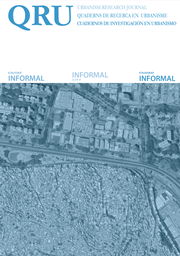LAS VIVIENDAS PRODUCTIVAS EN LA VILLA 20 DE LA CIUDAD AUTÓNOMADE BUENOS AIRES. Estrategias laborales y habitacionales de la migración boliviana
DOI:
https://doi.org/10.5821/qru.10394Keywords:
Hábitat popular, Viviendas productivas, Segregación urbana, Migración.Abstract
El objetivo de este trabajo es analizar las prácticas laborales llevadas a cabo por los hogares de migrantes (de Bolivia) en la Villa 20 (CABA, Argentina) y su relación con la configuración territorial segregada y fragmentada (el hábitat) en la actualidad. En especial, se hará hincapié en la temática de las viviendas productivas. En general, se hallaron vastos estudios sobre la problemática de la vivienda y del mercado laboral de la población migrante, pero escasean aquellos que se centren en la temática propuesta. Por este motivo, consideramos que este trabajo puede aportar de manera incipiente a una problemática en construcción. En síntesis se concluye que la vivienda productiva expresa un tipo específico de acceso a la ciudad y una inserción de los hogares de migrantes en el mercado laboral, segmentado étnicamente y según género, que recluye a las mujeres migrantes quechuas en el barrio. Además, esta situación problematiza la dicotomía de la modernidad público-privada.Para llevar a cabo esta propuesta se adoptó una estrategia metodológica multimétodo, que combina procedimientos cualitativos y cuantitativos.
Downloads
Published
Issue
Section
License
Those authors who have publications with this journal, accept the following terms:
a. Authors will retain their copyright and guarantee the journal the right of first publication of their work, which will be simultaneously subject to the Creative Commons CC BY-NC-ND-4.0 recognition license that allows third parties to share the work provided that its author and its first publication are indicated in this journal, but they cannot be changed or used commercially.
b. Authors may adopt other non-exclusive license agreements for the distribution of the version of the published work (eg: deposit it in an institutional telematic archive or publish it in a monographic volume) provided that the initial publication in this journal is indicated.
c. Authors are allowed and recommended to disseminate their work through the Internet (e.g. in institutional telematic files or on their website) before and during the submission process, which can lead to interesting exchanges and increase citations. of the published work. (See The effect of open access).













